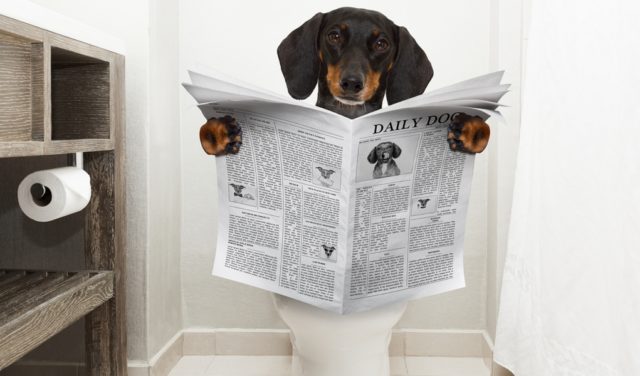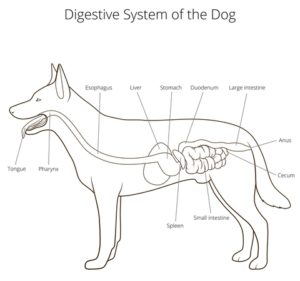
Table of Contents
Your dog’s digestion is important for good health and a long life. Feeding times and portion size can be confusing enough, but then you are also keeping track of what’s happening on the other end when your dog needs to go out and do his business. Just how long does it take for dogs to digest food?
 Your dog’s digestive system is responsible for more than just the absorption of food. It can also be an indicator of when something is going wrong. The digestive system is also responsible for preventing microorganisms and diseases from entering the body.
Your dog’s digestive system is responsible for more than just the absorption of food. It can also be an indicator of when something is going wrong. The digestive system is also responsible for preventing microorganisms and diseases from entering the body.
Keeping track of what is going on with your dog’s eating habits and waste is important in order to be aware of any health changes. Knowing how long dog digestion takes is helpful.
Generally, canned food moves through your dog’s system a little faster than dry food to completely digest, whereas all kibble dry food may take almost twice as long sometimes:
- Canned dog food: 4-6 hours
- Dry kibble: 8-10 hours
Your dog’s digestive system is only similar to yours, but it has its own unique differences that you should know. When your dog begins its digestion, many times, it starts before he even bites into his food. You can observe this when your dog begins to drool excessively. Let's not get ahead of ourselves. Let's first look at how long it takes for dogs to digest food.
How Long Does It Take for Dogs to Digest Food: How the Process Works
It Starts with Saliva
You may have already learned that Pavlov’s studies show that saliva is an important part of the digestive process. You, too, can notice that salivating begins when you offer food to your dog. Sometimes, your dog can begin drooling before he even sees any food, just from the smell of cooking food in the house.
Saliva does more than just keep your dog’s mouth nice and lubricated, and you need to learn this if you're trying to figure out how long it takes for dogs to digest food. It is the important beginning of the digestive process. Your dog has several different saliva glands that all have different functions in the mouth.
The dog’s slobber contains enzymes, and as your dog chews, the enzymes help break down starches into individual sugar molecules. As the dog chews up his food, the saliva moistens and begins breaking down the food to help lubricate its passage through the esophagus down into your dog’s stomach.
Now that your dog has chewed up his food and it has become a slippery blob, this blob is now scientifically known as “bolus,” according to National Geographic. The bolus is now on a journey through the esophagus, and the more saliva or the more slippery it is, the easier the journey will be. But how long does it take for dogs to digest food?
The Digestion Route
The bolus is now beginning its route through the digestive system, and it will now need to work its way through the esophagus. The esophagus is heavily muscled and actively pushes the bolus into the stomach. The muscle contracts in wave-like motions, moving the bolus along the esophagus path and into the stomach area.
Going into the stomach is just a part of the journey that the digestive route takes. After the stomach does its work, the path goes onward to the small intestine.
Once the small intestine absorbs needed nutrients, the journey continues to the large intestine or colon. After the material is further digested, it is finally passed out through the rectum. You recognize this end process when your dog takes that familiar position in the backyard.
The Stomach
The bolus moves from the esophagus into your dog’s stomach. Your dog’s stomach is a super-acidic environment. Being an omnivore, your dog is able to digest things like bone and raw meat.
In the stomach, the semi-solid food called bolus is rendered into a highly acidic goopy substance, which is now called “chyme.” The stomach muscles, along with the acidic environment, work much like a cement mixer and churn the food until it is nearly liquefied.
Your dog’s stomach acid is far more acidic than a human’s and is a type of hydrochloric acid. The lining of the stomach is covered with a thick mucus-like substance that naturally protects it from the strong acid. Now that your dog’s food has been further broken down by stomach acids and enzymes, it is now called chyme and is ready for the next part of the digestive system – the small intestine.
The Small Intestine
Now that the chyme has reached the small intestine, the real work of digestion (which is the removal of key nutrients that can be taken into the bloodstream and used by the body) is done. The small intestine is the longest part of the digestive system and can be up to 4 times the length of your dog’s body.
If you're wondering how long it takes for dogs to digest food, it's important to understand the path the food takes through your pup's body. At this point, the chyme moves through the small intestine, which has three distinct parts:
1. Duodenum
Chyme enters the duodenum from the stomach and here it is chemically treated with enzymes and hormones that are produced in the liver and pancreas. This chemical treatment will reduce the acid level of the chyme.
The bile and pancreatic ducts connect the duodenum to the gallbladder and the pancreas, which allows the enzymes produced by the liver and pancreas to mix in with the chyme and allow for further digestion. This portion of the small intestine is estimated to be about 10 inches long.
2. Jejunum
The chyme now begins to move through the longest part of the small intestine. The jejunum is filled with small finger-like projections known as villi. The millions of villi increase the surface area of the longest part of the small intestine, allowing for even better absorption of nutrients.
As the chyme moves through the jejunum, the villi work to absorb almost all usable nutrients and carry them into the bloodstream to be used by the cells throughout the body. Once the villi have removed the nutrients, the chyme is moved onward to the Ileum.
3. Ileum
The chyme is now a much thicker substance as it moves along, and much of the nutrients have been absorbed. The Ileum is a much shorter section that is similar to the jejunum in that it also contains villi. The main job of the Ileum is to use the villi to make sure that all available nutrients have been absorbed before the chyme is passed on to the large intestine.
RELATED: Top 5 Best Digestive Enzymes for Dogs
The Large Intestine
The large intestine is also known as the colon and is larger in diameter than the small intestine but not nearly as long. A large intestine can average about 16 inches long.
The large intestine connects the small intestine to the anus and has two primary functions. The first function is to keep the body hydrated by absorbing water and distributing it throughout the body. Its second function is to store fecal matter until it's ready for passage from the body.
Basically, the large intestine works much like a garbage compactor, which removes all the water and reconstitutes the chyme into a solid form called poop. It also provides storage until your dog is ready to go.
While the terms colon and large intestine are often used alike, scientifically, the large intestine can also be broken down into distinct parts. The first part of the large intestine is called the cecum and contains a small projection near where it connects to the small intestine.
Science does not know what this projection is for at this time. The colon is the longest part of the large intestine and further connects to the rectum, which is the third and final part of this section of the digestive system.
Waste Removal
Now that you know how your dog’s digestive system works and how long it takes for dogs to digest food, there is always a secondary problem. How should you deal with waste removal?
While it isn’t a ton of fun, it’s a job that has to be done. It’s good to handle it yourself, this way you can keep track of what is going on with your dog’s stools.
To make it easier, there are a number of scooper tools on the market. However, if this really isn’t your thing, there are a number of yard dog pooper scooper cleaning services that can be found in many areas.
READ NEXT: How To Choose and Buy the Right Dog Pooper Scooper














